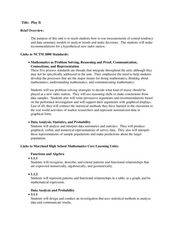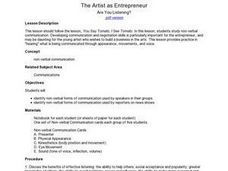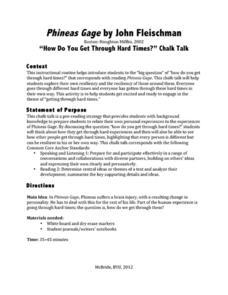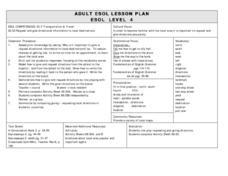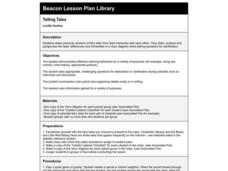Curated OER
Non-Verbal Communication
Many developmentally disabled students struggle with accurately conveying messages and interpreting those of others around them, especially when they are non-verbal. This lesson contains fun activities and exercises, such as talking with...
Curated OER
Teaching Summarization
Learning to differentiate major and minor textual events can help students learn how to summarize.
Curated OER
Giving Verbal Directions/ESOL
Students practice giving verbal directions accurately and employ correct prepositions and prepositional phrases and adverbs when giving those directions. They focus on using correct grammar, imperatives and infinitives when giving those...
Curated OER
Engaging Young Scientists with Inquiry: Part Two
Evaluating data and learning to communicate the results is a big piece of the inquiry puzzle.
Scholastic
Tell Us a Tale: Teaching Students to Be Storytellers
Encourage scholars to retell their favorite short story or folktale, adding personal details to make it their own. After reading their book of choice several times, story tellers retell a tale verbally to their classmates.
Curated OER
“The Story of an Hour” Extension Activities: Teacher’s Guide and Notes
Enhance and extend instruction of "The Story of an Hour" by Kate Chopin with one or all of these ideas. You might want to cover characterization and summary, or improve understanding of context clues and irony. You can cover any...
K20 LEARN
Brushstrokes: Communication/Using Descriptive Language
Sometimes a picture reflects a thousand descriptive words. To illustrate the importance of sensory words in descriptive writing, scholars listen to a song and craft a painting in response. After sharing their work with the class,...
Perkins School for the Blind
Timeline for Anne
It is key to the learning process to make everything a child with visual impairments does as tactile as possible. After reading Anne of Green Gables, the class discusses her life events in order to make a tactile time line. They...
Curated OER
Play It
There are a number of activities here that look at representing data in different ways. One activity, has young data analysts conduct a class survey regarding a new radio station, summarize a data set, and use central tendencies to...
Curated OER
The Artist as Entrepreneur: Are You Listening?
Pupils study non-verbal communication through appearance, movements and voice. They evaluate the non-verbal communication of television reporters and then participate in role-play scenarios using non-verbal communication.
Curated OER
Recycling!
The students recall events from Dr. Seuss' story The Lorax and make connections to environmental issues affecting their lives. They are expected to reflect on the facts of the story and respond verbally stating the inferences they made...
Curated OER
Industrialization of the American Landscape
Learners summarize the three sectors of industry and how these sectors applied to the Industrial Revolution. Students apply their skills in research and note-taking, as well as vocabulary building through web organizers. Learners...
Curated OER
Phineas Gage: “How Do You Get Through Hard Times?” Chalk Talk
Hold a discussion in writing about coping strategies to prepare your pupils for reading Phineas Gage: A Gruesome but True Story About Brain Science by John Fleischman. After journaling, pupils come up in an organized fashion and write...
Curated OER
Celebrations
Second graders answer questions after listening to the the story "Celebrating Life Around the World" and verbally identify three ways in which people celebrate special occasions. They then make two verbal connections from their own...
Curated OER
Foodborne Illness Educational Materials
Students work in teams to research and create educational material succinctly summarizing known salient fact, including prevention, of a particular foodborne illness. Pupils educational materials are presented in both oral and written...
Curated OER
The Lure and Lore of Weight Lifting
Students examine the importance of physical activity and positive reasons for weight training. They analyze and discuss a famous ad, read and summarize an article, and identify the benefits of resistance training.
Curated OER
Requesting Directions
Students work with their partners to role play giving and receiving directions to familiar and unfamiliar places. Students practice verifying directions through verbal repetition. This lesson is intended for students acquiring English.
Curated OER
Twelve Angry Men
Students assess their understanding of Twelve Angry Men. They create flashcards for vocabulary terms, summarize one of the acts, construct a diorama and complete character wheels. They choose from other activities including creating...
Curated OER
Math: Where Do I Put the Elephant?
Students listen to the story, "Harriet Goes to the Circus," to launch into a lesson on positional words, such as over, under, and behind. After clipping out and coloring pictures of circus animals, students place them into a parade line...
Curated OER
Spanish Politics
Students identify Spanish and other leaders, political parties, and ideas on a political continuum as a class. They verbally answer questions demonstrating comprehension of the text. Students summarize in writing in Spanish the main...
Curated OER
Giving and Receiving Compliments
Students explain why giving sincere compliments is important. In this communication lesson, students describe ways to compliment someone either verbal or nonverbal. They discuss their ideas in class.
Curated OER
European Union And Its Organizations
Tenth graders investigate the historical events surrounding the founding of the European Union. The teacher provides a handout to guide the activity and research. They answer questions verbally in the form of a class discussion. The...
Curated OER
Introduction to the History of the Michigan Supreme Court
Learners identify the players, events and changes in the history of the Supreme Court of Michigan. They explain the purpose of the Court in state government. They summarize the role and purpose of the Court.
Curated OER
Telling Tales
Students verbally tell partners a personal version of a fairy tale to each other. They listen, analyze, and describe the tales' differences and similarities in a Venn diagram.










